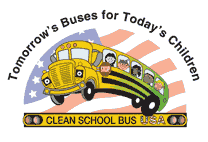Replacing Old School Buses -
What School Districts Should Consider

Making the Way for Environmentally Cleaner Buses
Introduction
Diesel engines can last a very long time. About one-third of all diesel school buses now in service were built before 1990. Older buses are not equipped with today's pollution control or safety features. Pre-1990 buses have been estimated to emit as much as six times more pollution as new buses that were built starting in 2004 and as much as sixty times more pollution as buses that meet the 2007 standards. These older buses are excellent candidates for replacement with newer, cleaner vehicles.
According to the Union of Concerned Scientists’ “School Bus Pollution Report Card”, over 75,000 pre-1990 school buses remain on the roads, carrying upwards of three million children to school. By replacing these oldest buses, we will make gains in reducing children’s exposure to diesel exhaust, as well as provide considerable safety improvements.
Replacement Engines or Repowers
If a school district is interested in replacing or repowering its diesel equipment or vehicles and it wants to get the cleanest engines available, it should purchase engines that have been certified to the most recent model year emission standards. They should be certified with particulate filters or traps, or be able to be equipped and delivered with such technologies. If purchasing alternate-fueled engines (e.g., compressed natural gas (CNG) engines, propane), make sure that the engines come equipped with catalysts or filters.
For a list of available natural gas vehicles and engines, visit Natural Gas Vehicles for America's guide (8 pp, 406K, March 2007). ![]()
![[logo] US EPA](https://webarchive.library.unt.edu/eot2008/20081106044935im_/http://www.epa.gov/epafiles/images/logo_epaseal.gif)